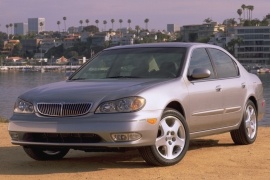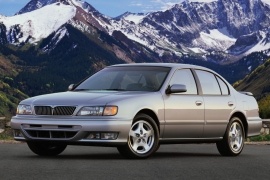INFINITI I Models/Series Timeline, Specifications & Photos
First production year: 1995
Engines: Gasoline
Infiniti introduced the third generation of the I-series (I30 and I35) in 1998 on the Japanese market named Nissan Cefiro, while the U.S. customers got it starting the following year as a 2000 model year.
Like on other occasions, Infiniti launched an upscale version of JDM-only Nissan vehicles on the American market, like this 2000 I30/I35. Its main competitors were the other two Japanese competitors from Acura and Lexus, namely the TL and the ES 300, respectively. It also had to compete against the Cadillac Catera. Even though it shared some mechanical parts with the Nissan Maxima, the materials used on the interior clearly transformed the I30/I35 into a premium vehicle.
The exterior resembled the Nissan Maxima, but thanks to its chromed grille and the redesigned apron, it offered a nicer image for the I30/I36. Its fluid lines lost any sharp angles and the car's slightly ascending beltline ended on the trunk lid that could've been adorned with a small wing. At the back, the taillights were extended from the quarter panels to the trunk's lid, with the reversing light placed at the top and a chromed slat running between them.
As said, the interior featured a nicer look than on the Maxima, but in terms of design, it was similar. The cabin's design followed the same ideas as the exterior, with curved lines from the center stack to the dashboard and rounded corners for the vents. The only angular shape was for the stereo installed above the climate control unit. Thanks to the 2" increase in the wheelbase, the rear passengers had decent legroom.
Nissan installed its new VQ family engines under the I30/I35's hood. But, despite boasting more power than the 1994 model year, the 2000 Infiniti I30/35 was slower on the 0 to 60 (0-97 kph) run than its predecessor.
Nissan started to grow its premium brand in the U.S. and rebadged its best-built vehicles from Japan as Infiniti, such as the i30, which was a Nissan Cefiro.
The Cefiro was based on the same platform as the Nissan Maxima, which was, in turn, a trendy choice for the mid-size segment customers. Moreover, since the Maxima was already on sale in the U.S., there were no problems with the spare parts. But the Infiniti i30 was more of a contender for the Lexus ES300 than for the American brands since it stood on a front-wheel-drive platform, and most of the Big-three premium vehicles were rear-wheel-drive.
On the outside, the I30 looked very similar to the Maxima, but it featured a different front fascia. Its leaves-looking grille and the wider air-intake in the lower bumper area imposed a premium feel. The long lines over the bodywork and the flat trunk set the image of a sporty mid-size sedan, light and agile. Its overall appearance was inspired by the Q45 sedan, including the taillights and the small wing on the trunk.
Inside, Infiniti offered standard leather seats, wood-trims, a two-way adjustable steering column, and a CD-stereo player. Power windows were also part of the standard package. The instrument cluster was similar to the one found in the Maxima, and it was very easy to read and understand the dials.
Under the hood, Infiniti put its badge on Maxima's 3.0-liter V6 engine, and the carmaker didn't even bother to give more hp to it. Unlike the Lexus, Infiniti offered its mid-size sedan with a manual gearbox while an automatic gearbox was on the options list.

